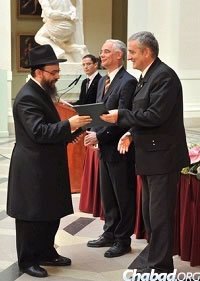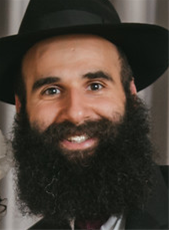The first in a series of three articles on Jewish life in Hungary.
In August of 1989, just before the Hungarian portion of the Iron Curtain came crashing down for good, young Rabbi Baruch Oberlander and Batsheva, his wife of five months, moved to Budapest, Hungary, to serve as Chabad-Lubavitch emissaries there.
Born in Williamsburg, N.Y., to survivors who had emigrated from Budapest following the Holocaust, Oberlander grew up hearing Hungarian alongside Yiddish, and was steeped in vivid memories of di alte heim (“the old home”). Yet he never imagined that he would one day return to Budapest to recreate that which his parents were sure was lost forever.
Situated in Central Europe, prewar Budapest was the lively epicenter of a diverse Jewish life.
Heavily influenced by Vienna and Berlin to the west, it was home to the upwardly mobile middle and upper classes, which built grand synagogues and lived in homes lining the stately Andrassy Avenue, modeled after Paris’ Champs-Élysées, as they sought to integrate into Hungarian society.
Yet it was also home to deeply pious Chassidim, dedicated to the teachings and lifestyles championed by the Chassidic Rebbes of the easternmost regions of the country, where Hungary, Ukraine and Romania meet in the shadow of the Carpathian Mountains. The successive ravages of Nazism and Communism, however, had taken their toll, and the once-proud Budapest Jewish community of nearly 200,000 strong had been halved in size and lost much of its grandeur.
First, the Need for Books
When they arrived, the Oberlanders discovered a kosher butcher shop, a bakery and synagogues, but very little in terms of vibrant Judaism that would speak to the younger generation. “The biggest events were Holocaust memorials,” says Oberlander. “There was nothing happy.”
One particular challenge was the fact that there had been almost no Jewish religious literature published in Hungarian since before the Holocaust, some 40 years earlier.

Oberlander, who was somewhat familiar with spoken Hungarian, immediately set to work expanding the selection. His first publication was a Hungarian translation of “This Is My God” by Herman Wouk. It was followed by “Think Jewish” by Rabbi Zalman Posner and other books. He also published a number of books by Chabad Chassid Naftali Kraus, a Hungarian-born Israeli journalist who never forgot about his former compatriots and wrote many books for them on a range of topics.
Especially important were the Hebrew-Hungarian siddurim (prayerbooks).
“Until then, the only bilingual siddurim were very old, mostly from before World War I,” Oberlander explains, “which were either in German or in archaic Hungarian with prayers for the well-being of the Emperor Franz Joseph. When the first Hungarian-Hebrew siddur was published in 1841, the purpose was not to teach Jews the meaning of the prayers—for they still understood Hebrew, and there were many Yiddish translations already available. Rather, they were printed to make Jews assimilate into the broader Hungarian culture. Of course, we had the opposite in mind: helping Hungarian Jews reclaim their Jewish heritage, which was often all but buried by years of repression.”

Since the majority of synagogues in Hungary prayed according to the non-Chassidic Ashkenazic liturgy, the new prayerbook—called Sámuel Imája—follows that rite. In the ensuing years, it was followed by machzorim for the High Holidays and other books. A transliterated siddur is slated for release in March.
To date, the most popular publication has been two editions of the Passover Haggadah, which has sold more than 30,000 copies.
Adult Education and a ‘Bet Din’
Another area sorely lacking was that of adult education. Oberlander, who had been giving a course on Jewish law at the venerable 450-year-old ELTE (Eötvös Loránd University) since 1991, founded an “open university” where people studied Torah topics, using original coursework that he developed. Today, located in the modern Keren Or Chabad center, it attracts dozens of attendees, who participate in lectures from a roster of Chabad rabbis on a nightly basis.
In 1998, it was followed by the Pesti Jesiva, an institution for advanced Torah studies with a core of students from the United States and Israel, who were soon joined by young Hungarian Jews whose appetite for Judaism was whetted by Oberlander’s classes.
Pesti Jesiva also served as a source of rabbinic talent, as many of the country’s Chabad rabbis are locals whose first taste of Judaism was right there at the institution, coupled with foreign students who were enchanted by the local community and never left. They include Israeli-born Rabbi Shmuel Raskin (’01), who serves as rabbi of the Israeli community and director of the Keren Or Chabad Israeli Center; local-born Rabbi Asher Faith (’04), who serves as youth director; Israeli-born Rabbi Shmuel Feigen (’08), who serves as rabbi in Debrecen; and Rabbi Shmuel Glitsenstein, who serves as rabbi at the Nagyfuvaros Utca synagogue. Other rabbis, such as Slomó Köves (’01), Menachem Mendel Nógrádi and Yehoshua Fuchs, also studied there.
Another area Oberlander noticed was sorely lacking was that of a functioning bet din (ecclesiastical court) to perform lifecycle events and conversions, and supply kosher food produced at the highest standards.

To fill the void, Oberlander, joined by Köves and Rabbi Sholom Hurwitz, formed the country’s only permanent bet din in 2008, with Oberlander serving as av bet din (head of the court).
One area of service is certifying people’s Jewish identity, ensuring that they and their children will be accepted in Jewish communities around the globe. Since some of Hungary’s Jews had intermarried as early as the mid-1800s—and many more sought to repress their Jewish identity following the Holocaust and during the Communist years—Oberlander says it is a painstaking, though rewarding, process.
“There was one young man who came to us claiming that his maternal grandmother was Jewish, but there was no documentation to back his claims,” Oberlander recalls. “I asked to speak to the grandmother, who had the most amazing tale.
“She told me that she was born in a small border town in the Carpathian Mountains. One day, when she was 8, she left home to get some milk. Right then, the Nazis marched into town. Watching from a distance, she saw them taking away her family on a truck.
Wearing just a sweater, she hid in the snow on a hill overlooking the city for the rest of the day. Relatives living in a different city spirited her to Budapest, where she was adopted by a non-Jewish woman.
“She continued to tell me that she tried hard to forget Yiddish and the prayers she had learned in her childhood. She did not even tell her husband that she was Jewish until 1984.
“I quizzed her about Jewish foods and holidays, and she knew everything, but how was I to know if she was a Jewish child or perhaps a non-Jew who had worked in a Jewish home? At one point, I asked her if she remembered going to synagogue. She looked at me strangely and said, ‘What? Girls don’t go to synagogue!’ This was indeed largely true in rural communities in those days, and I instinctively felt that she was telling the truth. But I still had no paper to prove it.”
During the course of the conversation, Oberlander saw that the woman’s daughter was crying. It was the first time she had heard the full story of her mother’s childhood.
Eventually, she was able to produce a cache of postmarked letters between her and her since-deceased cousin in Israel that corroborated the story, and the family was certified as bona fide Jews. As a result, the grandson came closer to Judaism, underwent circumcision, and is now married to a Jewish woman.
The bet din also certifies a growing line of kosher meats, dairy items and other staples, in addition to two kosher restaurants.
In response to the recent resurgence of xenophobia in Hungarian politics and public discourse, Chabad invited leaders of other major Jewish organizations to found the Action and Protection Foundation, which monitors and combats anti-Semitism. In December of last year, the foundation’s inauguration was attended by Jewish Agency chairman Natan Sharansky; World Zionist Organization chair Avraham Duvdevani; and other Israeli and Hungarian officials.

Taking Care of the Young and Old
Of course, no community infrastructure can be built without having the very young and very old in mind as well.
Since 2003, Rabbi Köves—an early protégé of Oberlander’s who studied in yeshivahs in France, the United States and Israel before returning to Pesti Jesiva in 2009—has been serving as the country’s only mohel, or ritual circumciser. He says he performs his sacred craft for dozens of families every year. Also rabbi at the magnificently renovated Óbuda synagogue, which was built in 1820 in classic French Empire style, he is responsible for much of the day-to-day growth and administration of Chabad in Hungary.
Chabad’s Gan Menachem kindergarten and Beis Menachem school—directed by Rebbetzin Batsheva Oberlander—recently moved into a spacious new former public school on Dohány Street, which once formed the border of the Jewish ghetto built by the Nazis. “Since this was the Jewish neighborhood, we have parents who went to the school as children,” Oberlander notes. “Now, their children are going to the same building—but they are going to study Torah.”
At the other end of the journey of life, Chabad recently acquired a string of old-age homes for 1,200 people. While many of the residents are not Jewish, the Jewish people who live in the homes are now able to request and receive kosher meals, and have access to rabbinical care and other amenities.
Yet even as Chabad continues to grow Budapest’s Jewish infrastructure, Rabbi Oberlander insists that they retain their original philosophy of teaching and working with each individual.
“The other week, we celebrated the bar mitzvah of a boy whose mother was a student of mine in law school nearly 20 years ago,” he says. “It was just beautiful to see how we have been a part of their lives for so many years.”







Join the Discussion